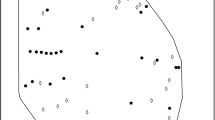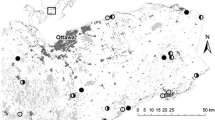Abstract
Three categories of wetland assessment methods have been recognized by the United States Environmental Protection Agency, including Level 1—Landscape-scale Assessment; Level 2—Rapid Field Methods; and Level 3—Intensive Biological and Physico–Chemical Measures. This study incorporates wetland assessment methods for each assessment level, including the Level 1 Landscape Development Intensity (LDI) index, Level 2 Wetland Rapid Assessment Procedure (WRAP), and Level 3 Florida Wetland Condition Index (FWCI). Using a neighborhood analysis in Geographic Information Systems (GIS), an LDI index map was created using 1995 land use, creating a calculated LDI index value for each 30 m2 area in Florida. Level 1–3 assessment procedures were employed at 193 palustrine emergent (n = 75) and forested (n = 118) wetlands. Significant correlations were found among the multiple Level 1–3 assessment procedures using the nonparametric Spearman’s correlation coefficient for pair-wise comparisons of LDI and WRAP, LDI and diatom FWCI, WRAP and diatom FWCI, LDI and macrophyte FWCI, WRAP and macrophyte FWCI, LDI and macroinvertebrate FWCI, and WRAP and macroinvertebrate FWCI (|r| > 0.50, P < 0.01). Defining the relationship between Level 1–3 assessment methods may be used to estimate the more intensive and species assemblage-specific Level 3 FWCI assessment scores for wetlands with Level 1 or Level 2 scores. Inferences can then be made as to wetland condition based on established correlations with intensive assessment methods.




Similar content being viewed by others
Reference
Adams SM (2002) Biological indicators of aquatic ecosystem stress: introduction and overview. In: Adams SM (editor). Biological Indicators of Aquatic Ecosystem Stress, Bethesda, MD: American Fisheries Society, pp 1–11
Allan JD, Erickson DL, Fay J (1997) The influence of catchment land use on stream integrity across multiple spatial scales. Freshwater Biology 37:149–161
Ammann AP, Stone AL (1991) Method for the Comparative Evaluation of Nontidal Wetlands in New Hampshire, Concord, NH: New Hampshire Department of Environmental Services, NHDES-WRD-1991-3
Analyse-it Software, Ltd (1997–2003) Analyse-it, Version 1.67 [computer program], Leeds, UK
Bahls L (1993) Periphyton Bioassessment Methods for Montana Streams, Helena, MT: Water Quality Bureau, Department of Health and Environmental Science
Barbour MT, Gerritsen J, White JS (1996) Development of the Stream Condition Index (SCI) for Florida, Owing Mills, MD: A Report to the Florida Department of Environmental Protection, Stormwater and Nonpoint Source Management Section. Prepared by Tetra Tech, Inc
Belanger TV, Scheidt DJ, Platko JR (1989) Effects of nutrient enrichment on the Florida Everglades. Lake and Resource Management 5:101–111
Brinson MM, Malvárez AI (2002) Temperate freshwater wetlands: types, status, and threats. Environmental Conservation 29:111–133
Brooks RP, Wardrop DH, Bishop JA (2002) Watershed-based Protection for Wetlands in Pennsylvania: Levels 1 & 2 — Synoptic Maps and Rapid Field Assessments, University Park, PA: Penn State Cooperative Wetlands Center Report No. 2002-1
Brown MT, Ulgiati S (2005) Chapter 14: Emergy, transformity, and ecosystem health. In: Jørgensen SE, Costanza R, Xu F (editors). Handbook of Ecological Indicators for Assessment of Ecosystem Health, Boca Raton, FL: CRC Press, pp 333–352
Brown MT, Vivas MB (2005) Landscape Development Intensity Index. Environmental Monitoring and Assessment 101:289–309
Cohen MJ, Lane CR, Carstenn SM (2004) Evaluation of Floristic Quality Indices for biotic assessment of depressional marsh condition in Florida. Ecological Applications 14:784–794
Cowardin LM, Carter V, Goulet FC, LaRoe ET (1979) Classification of Wetlands and Deepwater Habitats of the United States, Washington, DC: United States Department of the Interior, Fish and Wildlife Service
Crosbie B, Chow-Fraser P (1999) Percentage land use in the watershed determines the water and sediment quality of marshes in the Great Lakes basin. Canadian Journal of Fisheries and Aquatic Sciences 56:1781–1791
Dahl TE (2000) Status and Ttrends of Wetlands in the Conterminous United States 1986 to 1997, Washington, DC: United States Department of the Interior, Fish and Wildlife Service
Ehrenfeld JG (1983) The effects of changes in land-use on swamps of the New Jersey pine barrens. Biological Conservation 25:353–375
Environmental Systems Research Institute (ESRI), Inc. (1999) ArcView 3.2 ESRI® [computer program], Redlands, CA
Environmental Systems Research Institute (ESRI), Inc. (1999–2002) ArcGIS ESRI® ArcMapTM 8.3 [computer program], Redlands, CA
FDOT [Florida Department of Transportation] (1999) Florida Land Use, Cover and Forms Classification System [handbook], Department of Transportation, Surveying and Mapping, Geographic Mapping Section. Available: http://www.dot.state.fl.us/surveyingandmapping/geographic.htm#fluccs [accessed August 15, 2004]
Fennessy MS, Jacobs AD, Kentula ME (2004) Review of Rapid Assessment Methods for Assessing Wetland Condition, Corvallis, OR: National Health and Environmental Effects Research Laboratory, Office of Research and Development, United States Environmental Protection Agency, EPA-620-R-04-009. Available: http://www.epa.gov/owow/wetlands/monitor/RapidMethodReview.pdf [accessed September 2005]
Findlay CST, Bourdages J (2000) Response time of wetland biodiversity to road construction on adjacent lands. Conservation Biology 14:86–94
Fore LS, Grafe C (2002) Using diatoms to assess the biological condition of large rivers in Idaho (U.S.A.). Freshwater Biology 47:2015–2037
Furgo East, Inc. (1995) A Method for the Assessment of Wetland Function, Baltimore, MD: Maryland Department of the Environment
Galatowitsch SM, Whited DC, Lehtinen R, Husveth J, Schik K (2000) The vegetation of wet meadows in relation to their land-use. Environmental Monitoring and Assessment 60:121–144
Hasle GR, Fryxell GA (1970) Diatoms: cleaning and mounting for light and electron microscopy. Transactions of the American Microscopy Society 89:469–474
Hicks AL, BK Carlisle (1998) Rapid Habitat Assessment Methods, Macro-Invertebrate Survey Version: Brief Description and Methodology, Amherst, MA: Massachusetts Coastal Zone Management Wetland Assessment Program
Karr JR (1981) Assessment of biotic integrity using fish communities. Fisheries 6:21–27
Karr JR, Chu EW (1997) Biological Monitoring and Assessment: Using Multimetric Indexes Effectively, Seattle, WA: University of Washington, EPA 235-R-97-001
Kerans BL, Karr JR (1994) A benthic index of biotic integrity (B-IBI) for rivers in the Tennessee valley. Ecological Applications 4:768–785
Lane CR (2000) Proposed Ecological Regions for Freshwater Wetlands of Florida, Gainesville, FL: Masters Thesis, University of Florida
Lane CR (2003) Biological Indicators of Wetland Condition for Isolated Depressional Herbaceous Wetlands in Florida, Gainesville, FL: PhD Dissertation, University of Florida
Mack JJ (2001a) Ohio Rapid Assessment Method for Wetlands v 5.0: User’s Manual and Forms, Columbus, OH: Ohio Environmental Protection Agency, Division of Surface Water Technical Report WET/2001-1
Mack JJ (2001b) Vegetation Index of Biological Integrity (VIBI) for Wetlands: Ecoregional, Hydrogeomorphologic, and Plant Community Comparisons with Preliminary Wetland Aquatic Life Use Designations. Final Report to the United States Environmental Protection Agency Grant No. CD985875, Vol 1, Columbus, OH: Wetland Ecology Group, Division of Surface Water, Ohio Environmental Protection Agency. Available: http://www.epa.state.oh.us/dsw.wetlands/wetlands_bioasses.html [accessed June 2003]
MBWSR [Minnesota Board of Water and Soil Resources] (2003) Minnesota Routine Assessment Method for Evaluating Wetland Function (MNRAM) Version 3.0, St. Paul, MN: Minnesota Board of Water and Soil Resources
Miller RE Jr, Gunsalus BE (1999) Wetland Rapid Assessment Procedure (WRAP), West Palm Beach, FL: South Florida Water Management District, Technical Publication REG-001
MJM Software (2002) PCORD Version 4.1 [computer program], Glenden Beach, OR
O’Connell TJ, Jackson LE, Brooks RP (1998) A bird community index of biotic integrity for the mid-Atlantic highlands. Environmental Monitoring and Assessment 51:145–156
Odum HT (1996) Environmental Accounting: Emergy and Environmental Decision Making, New York: John Wiley & Sons
Redfield G, Chimney M, Goforth G, Rizzardi K (2000) Chapter 1: Introduction to the 2000 Everglades consolidation report. In: Everglades Consolidated Report, West Palm Beach, FL: South Florida Water Management District
Reiss KC (2004) Developing Biological Indicators for Isolated Forested Wetlands in Florida, Gainesville, FL: PhD Dissertation, University of Florida
Reiss KC (2006) Florida Wetland Condition Index for depressional forested wetlands. Ecological Indicators 6:337–352
Reiss KC, Brown MT (2005) Pilot Study—the Florida Wetland Condition Index (FWCI): Preliminary Development of Biological Indicators for Forested Strand and Floodplain Wetlands, Gainesville, FL: Howard T. Odum Center for Wetlands, University of Florida. Available: http://www.dep.state.fl.us/labs/library/index.htm [accessed July 2005]
Roth NE, Allan JD, Erickson DL (1996) Landscape influences on stream biotic integrity assessed at multiple spatial scales. Landscape Ecology 11:141–156
Schulz EJ, Hoyer MV, Canfield DE Jr (1999) An index of biotic integrity: a test with limnological and fish data from sixty Florida lakes. Transactions of the American Fisheries Society 128:564–577
USEPA [United States Environmental Protection Agency] (2002) Methods for Evaluating Wetland Condition: Introduction to Bbiological Assessment, Washington, DC: Office of Water, EPA-822-R-02-014
van Dam H, Mertens A, Sinkeldam J (1994) A coded checklist and ecological indicator values of freshwater diatoms from the Netherlands. Netherlands Journal of Aquatic Ecology 28:117–133
Acknowledgments
Florida ecological indicator research was supported by a grant from the Florida Department of Environmental Protection (FDEP), Contract #WM683: Development of a Biological Approach for Assessing Wetland Function and Integrity. FDEP’s Russ Frydenborg, Ellen McCarron, Ashley O’Neal, and Erica Hernandez provided invaluable project management, oversight, encouragement, and substantive review of the research over the duration of the project. We acknowledge the work of Charles Lane creating the herbaceous Florida Wetland Condition Index, and the field and laboratory contributions provided by J. Baker, E. Bardi, S. Carstenn, M. Cohen, T. Davanzo, M. Fowlkes, M. Friedman, S. Meyer, A. Moore, M. Murray-Hudson, M. Otto, E. Spurrier, M. Stevens, J. Surdick, and M.B. Vivas. We also extend our appreciation for the comments from three anonymous reviewers, who helped strengthen and clarify the article.
Author information
Authors and Affiliations
Corresponding author
Rights and permissions
About this article
Cite this article
Reiss, K.C., Brown, M.T. Evaluation of Florida Palustrine Wetlands: Application of USEPA Levels 1, 2, and 3 Assessment Methods. EcoHealth 4, 206–218 (2007). https://doi.org/10.1007/s10393-007-0107-3
Received:
Accepted:
Published:
Issue Date:
DOI: https://doi.org/10.1007/s10393-007-0107-3




